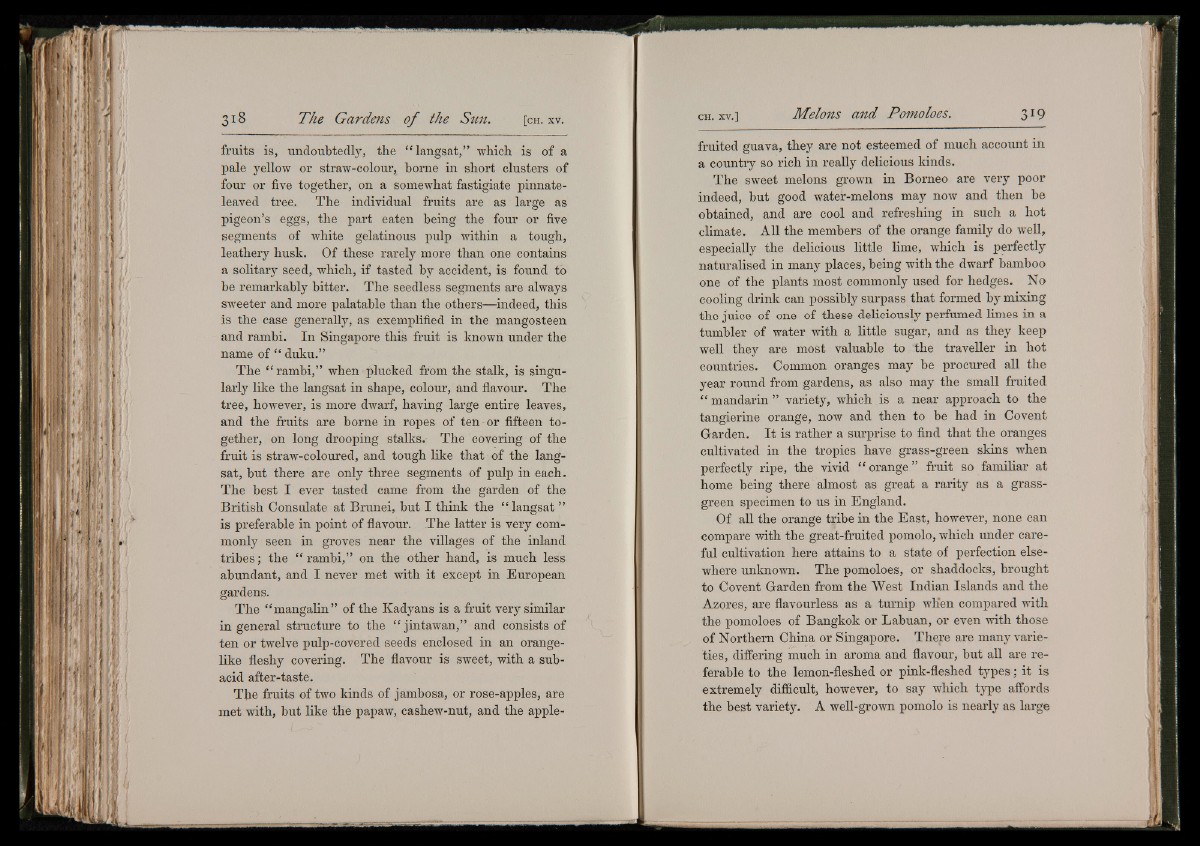
fruits is, undoubtedly, the “ langsat,” which is of a
pale yellow or straw-colour, borne in short clusters of
four or five together, on a somewhat fastigiate pinnateleaved
tree. The individual fruits are as large as
pigeon’s eggs, the part eaten being the four or five
segments of white gelatinous pulp within a tough,
leathery husk. Of these rarely more than one contains
a solitary seed, which, if tasted by accident, is found to
be remarkably bitter. The seedless segments are always
sweeter and more palatable than the others—indeed, this
is the case generally, as exemplified in the mangosteen
and rambi. In Singapore this fruit is known under the
name of “ duku.”
The “ rambi,” when-plucked from the stalk, is singularly
like the langsat in shape, colour, and flavour. The
tree, however, is more dwarf, having large entire leaves,
and the fruits are borne in ropes of ten or fifteen together,
on long drooping stalks. The covering of the
fruit is straw-coloured, and tough like that of the langsat,
but there are only three segments of pulp in each.
The best I ever tasted came from the garden of the
British Consulate at Brunei, but I think the “ langsat ”
is preferable in point of flavour. The latter is very commonly
seen in groves near the villages of the inland
tribes; the “ rambi,” on the other hand, is much less
abundant, and I never met with it except in European
gardens.
The “mangalin” of the Kadyans is a fruit very similar
in general structure to the “ jintawan,” and consists of
ten or twelve pulp-covered seeds enclosed in an orangelike
fleshy covering. The flavour is sweet, with a subacid
after-taste.
The fruits of two kinds of jambosa, or rose-apples, are
met with, but like the papaw, cashew-nut, and the applefruited
guava, they are not esteemed of much account in
a country so rich in really delicious kinds.
The sweet melons grown in Borneo are very poor
indeed, but good water-melons may now and then be
obtained, and are cool and refreshing in such a hot
climate. All the members of the orange family do well,
especially the delicious little lime, which is perfectly
naturalised in many places, being with the dwarf bamboo
one of the plants most commonly used for hedges. No
cooling drink can possibly surpass that formed by mixing
the juice of one of these deliciously perfumed limes in a
tumbler of water with a little sugar, and as they keep
well they are most valuable to the traveller in hot
countries. Common oranges may be procured all the
year round from gardens, as also may the small fruited
“ mandarin” variety, which is a near approach to the
tangierine orange, now and then to be had in Covent
Garden. It is rather a surprise to find that the oranges
cultivated in the tropics have grass-green skins when
perfectly ripe, the vivid “ orange ” fruit so familiar at
home being there almost as great a rarity as a grass-
green specimen to us in England.
Of all the orange tribe in the East, however, none can
compare with the great-fruited pomolo, which under careful
cultivation here attains to a state of perfection elsewhere
unknown. The pomoloes, or shaddocks, brought
to Covent Garden from the West Indian Islands and the
Azores, are flavourless as a turnip wh'en compared with
the pomoloes of Bangkok or Labuan, or even with those
of Northern China or Singapore. There are many varieties,
differing much in aroma and flavour, but all are referable
to the lemon-fleshed or pink-fleshed types; it is
extremely difficult, however, to say which type affords
the best variety. A well-grown pomolo is nearly as large